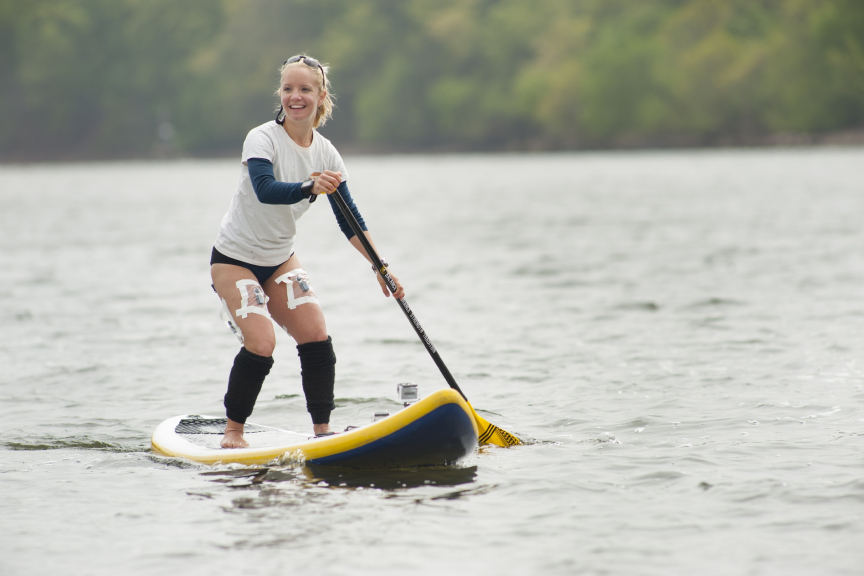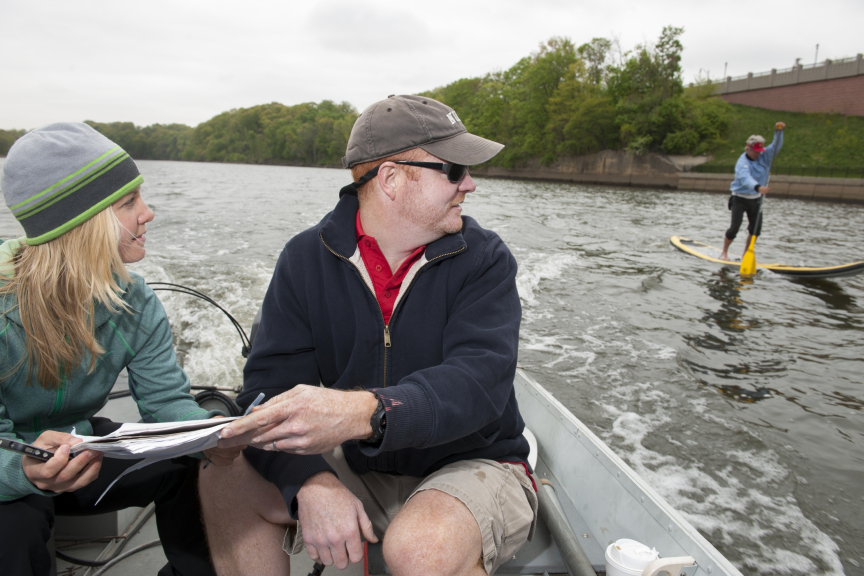Shannon MacDowell helps bring aquatic sport to Rutgers

Stand up paddle boarding, known as SUP or “supping” to its followers, may seem like a novelty mash-up of surfing and kayaking. But one Rutgers alumna is on a mission to show that this avant-garde water sport is much more than a fad.
“You’re standing up, the board is moving, the sun is on you. It’s so much fun,” says Shannon MacDowell, who teaches stand up paddle boarding at the Manhattan Kayak Company Pier 66 Boathouse on 26thStreet. “It’s also one of the greatest full-body workouts you can get.”
With the help of her alma mater, BTS Bioengineering Corp. and Manhattan Kayak Company, MacDowell and her business partner Carey Bond have embarked on a research project that seeks to better understand the physiology underlying stand up paddle boarding and use the science to publicize its value as a form of exercise and recreation.
“The sport is so new, there isn't a lot of research out there to document what’s actually occurring in the body,” says MacDowell, a trained dancer who graduated from Rutgers’ Mason Gross School of the Arts in 2009. “Using BTS’s wireless technology, we are collecting objective scientific data on the muscle activity in a SUP stroke for the first time.”
The study – funded by Suplogix LLC (cofounded by MacDowell and Bond) and the Manhattan Kayak Company – has been taking place during April and May at Rutgers’ Werblin Center pool on the Busch Campus and at the Class of 1914 Boathouse on the Raritan River.
MacDowell began her research at the university after contacting her former Mason Gross professors and the aquatics staff at Rutgers Recreation. “For me it was kind of a no-brainer,” says MacDowell. “Rutgers is historically a research-oriented institution. They were happy to help out,” she says.

The project uses EMG (electromyography) to measure muscle activity when the body is engaged in a SUP forward stroke. MacDowell and Bond, along with a tech team headed by BTS’s Davide Ferrario and physical therapist James Grierson, monitor experienced paddle boarders outfitted with electrodes to record muscle activity. BTS has been involved in similar sports-related studies, MacDowell says.
MacDowell, who moved to New York after graduating from Rutgers to join the Amy Marshall Dance Company, was introduced to supping by Eric Stiller, founder of the Manhattan Kayak Company and pioneer supper. He put the word out he was looking for someone to teach Pilates on the boards. As a recreational kayaker, professional dancer, certified personal trainer and certified Pilates instructor, MacDowell was the perfect fit.
MacDowell admits she was nervous her first time out as she found herself paddling across the Hudson River with its blasting winds and powerful current. But after a few wobbly moments on the board, supping felt very natural, and she was smitten.
“Because of my dance training, I was accustomed to shifting my weight through different planes of motion,” says MacDowell, who continues to perform with several Manhattan-based modern dance companies.
Born and raised in Anchorage, Alaska, MacDowell has been in the water since she was able to walk and spent her childhood kayaking with her family in the fjords in the southern part of the state. It is her background and training as a dancer, though, that adds a harmonious sense of rhythm and spirit to the budding sport.
As one of the few dancers in the SUP community, MacDowell brings to supping an interdisciplinary approach cultivated during her time at Mason Gross.
“The dance department [at Mason Gross] is very invested in teaching the function of the body . . . the science beneath the movement,” says MacDowell, who applied early decision to Mason Gross, which she found searching the web for colleges with strong dance programs. “I visited Rutgers the summer of junior year in high school and completely loved it,” she says
MacDowell credits John Tuohy, the associate director of aquatics and outdoor recreation, and Meghan Higgins, outdoor recreation coordinator, for helping to set up the data collection days at the Werblin Center’s 50-meter indoor pool and at the Rutgers Boathouse. “This has been an amazing opportunity for a real merging of science, sport and art,” MacDowell adds.
Most recently, MacDowell has been working with the recreation department’s aquatics unit to design a SUP program at Rutgers, which will be based out of the Raritan Boathouse.
Tuohy said the experience of hosting MacDowell and her group has been “super exciting.” Rutgers Recreation had been planning to offer a paddle boarding class this fall as part of its Go Outdoors program when MacDowell’s came in.
“The sport is in its infancy, but here’s a group that’s been doing it for a long time,” said Tuohy.
“The image I have in my mind is that, once our program is established, Rutgers paddle boarders would work with the folks at the Manhattan Kayak Company. We could paddle out and meet up at a place like Sandy Hook
Look for more information about Rutgers’ SUP program on the Go Outdoors website in August.